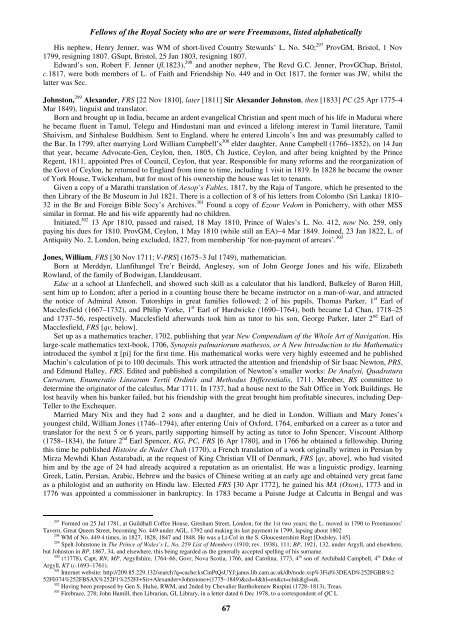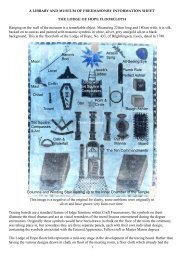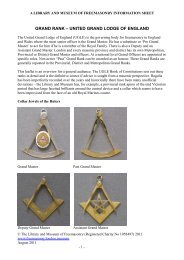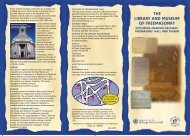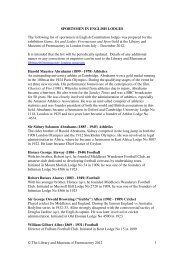FREEMASONS AND THE ROYAL SOCIETY Alphabetical List of ...
FREEMASONS AND THE ROYAL SOCIETY Alphabetical List of ...
FREEMASONS AND THE ROYAL SOCIETY Alphabetical List of ...
Create successful ePaper yourself
Turn your PDF publications into a flip-book with our unique Google optimized e-Paper software.
Fellows <strong>of</strong> the Royal Society who are or were Freemasons, listed alphabetically<br />
His nephew, Henry Jenner, was WM <strong>of</strong> short-lived Country Stewards’ L. No. 540; 297 ProvGM, Bristol, 1 Nov<br />
1799, resigning 1807. GSupt, Bristol, 25 Jan 1803, resigning 1807.<br />
Edward’s son, Robert F. Jenner (fl.1823), 298 and another nephew, The Revd G.C. Jenner, ProvGChap, Bristol,<br />
c.1817, were both members <strong>of</strong> L. <strong>of</strong> Faith and Friendship No. 449 and in Oct 1817, the former was JW, whilst the<br />
latter was Sec.<br />
Johnston, 299 Alexander, FRS [22 Nov 1810], later [1811] Sir Alexander Johnston, then [1833] PC (25 Apr 1775–4<br />
Mar 1849), linguist and translator.<br />
Born and brought up in India, became an ardent evangelical Christian and spent much <strong>of</strong> his life in Madurai where<br />
he became fluent in Tamul, Telegu and Hindustani man and evinced a lifelong interest in Tamil literature, Tamil<br />
Shaivism, and Sinhalese Buddhism. Sent to England, where he entered Lincoln’s Inn and was presumably called to<br />
the Bar. In 1799, after marrying Lord William Campbell’s 300 elder daughter, Anne Campbell (1766–1852), on 14 Jun<br />
that year, became Advocate-Gen, Ceylon, then, 1805, Ch Justice, Ceylon, and after being knighted by the Prince<br />
Regent, 1811, appointed Pres <strong>of</strong> Council, Ceylon, that year. Responsible for many reforms and the reorganization <strong>of</strong><br />
the Govt <strong>of</strong> Ceylon, he returned to England from time to time, including 1 visit in 1819. In 1828 he became the owner<br />
<strong>of</strong> York House, Twickenham, but for most <strong>of</strong> his ownership the house was let to tenants.<br />
Given a copy <strong>of</strong> a Marathi translation <strong>of</strong> Aesop’s Fables, 1817, by the Raja <strong>of</strong> Tangore, which he presented to the<br />
then Library <strong>of</strong> the Br Museum in Jul 1821. There is a collection <strong>of</strong> 8 <strong>of</strong> his letters from Colombo (Sri Lanka) 1810–<br />
32 in the Br and Foreign Bible Socy’s Archives. 301 Found a copy <strong>of</strong> Ezour Vedom in Ponicherry, with other MSS<br />
similar in format. He and his wife apparently had no children.<br />
Initiated, 302 13 Apr 1810, passed and raised, 18 May 1810, Prince <strong>of</strong> Wales’s L. No. 412, now No. 259, only<br />
paying his dues for 1810. ProvGM, Ceylon, 1 May 1810 (while still an EA)–4 Mar 1849. Joined, 23 Jan 1822, L. <strong>of</strong><br />
Antiquity No. 2, London, being excluded, 1827, from membership ‘for non-payment <strong>of</strong> arrears’. 303<br />
Jones, William, FRS [30 Nov 1711; V-PRS] (1675–3 Jul 1749), mathematician.<br />
Born at Merddyn, Llanfihangel Tre’r Beirdd, Anglesey, son <strong>of</strong> John George Jones and his wife, Elizabeth<br />
Rowland, <strong>of</strong> the family <strong>of</strong> Bodwigan, Llanddeusant.<br />
Educ at a school at Llanfechell, and showed such skill as a calculator that his landlord, Bulkeley <strong>of</strong> Baron Hill,<br />
sent him up to London; after a period in a counting house there he became instructor on a man-<strong>of</strong>-war, and attracted<br />
the notice <strong>of</strong> Admiral Anson. Tutorships in great families followed; 2 <strong>of</strong> his pupils, Thomas Parker, 1 st Earl <strong>of</strong><br />
Macclesfield (1667–1732), and Philip Yorke, 1 st Earl <strong>of</strong> Hardwicke (1690–1764), both became Ld Chan, 1718–25<br />
and 1737–56, respectively. Macclesfield afterwards took him as tutor to his son, George Parker, later 2 nd Earl <strong>of</strong><br />
Macclesfield, FRS [qv, below].<br />
Set up as a mathematics teacher, 1702, publishing that year New Compendium <strong>of</strong> the Whole Art <strong>of</strong> Navigation. His<br />
large-scale mathematics text-book, 1706, Synopsis palmariorum mathesos, or A New Introduction to the Mathematics<br />
introduced the symbol π [pi] for the first time. His mathematical works were very highly esteemed and he published<br />
Machin’s calculation <strong>of</strong> pi to 100 decimals. This work attracted the attention and friendship <strong>of</strong> Sir Isaac Newton, PRS,<br />
and Edmund Halley, FRS. Edited and published a compilation <strong>of</strong> Newton’s smaller works: De Analysi, Quadratura<br />
Curvarum, Enumeratio Linearum Tertii Ordinis and Methodus Differentialis, 1711. Member, RS committee to<br />
determine the originator <strong>of</strong> the calculus, Mar 1711. In 1737, had a house next to the Salt Office in York Buildings. He<br />
lost heavily when his banker failed, but his friendship with the great brought him pr<strong>of</strong>itable sinecures, including Dep-<br />
Teller to the Exchequer.<br />
Married Mary Nix and they had 2 sons and a daughter, and he died in London. William and Mary Jones’s<br />
youngest child, William Jones (1746–1794), after entering Univ <strong>of</strong> Oxford, 1764, embarked on a career as a tutor and<br />
translator for the next 5 or 6 years, partly supporting himself by acting as tutor to John Spencer, Viscount Althorp<br />
(1758–1834), the future 2 nd Earl Spencer, KG, PC, FRS [6 Apr 1780], and in 1766 he obtained a fellowship. During<br />
this time he published Histoire de Nader Chah (1770), a French translation <strong>of</strong> a work originally written in Persian by<br />
Mirza Mewhdi Khan Astarabadi, at the request <strong>of</strong> King Christian VII <strong>of</strong> Denmark, FRS [qv, above], who had visited<br />
him and by the age <strong>of</strong> 24 had already acquired a reputation as an orientalist. He was a linguistic prodigy, learning<br />
Greek, Latin, Persian, Arabic, Hebrew and the basics <strong>of</strong> Chinese writing at an early age and obtained very great fame<br />
as a philologist and an authority on Hindu law. Elected FRS [30 Apr 1772], he gained his MA (Oxon), 1773 and in<br />
1776 was appointed a commissioner in bankruptcy. In 1783 became a Puisne Judge at Calcutta in Bengal and was<br />
297<br />
Formed on 25 Jul 1781, at Guildhall C<strong>of</strong>fee House, Gresham Street, London, for the 1st two years; the L. moved in 1790 to Freemasons’<br />
Tavern, Great Queen Street, becoming No. 449 under AGL, 1792 and making its last payment in 1799, lapsing about 1802<br />
298<br />
WM <strong>of</strong> No. 449 4 times, in 1827, 1828, 1847 and 1848. He was a Lt-Col in the S. Gloucestershire Regt [Dodsley, 145].<br />
299<br />
Spelt Johnstone in The Prince <strong>of</strong> Wales’s L. No. 259 <strong>List</strong> <strong>of</strong> Members (1910; rev. 1938), 111; BP, 1921, 132, under Argyll, and elsewhere,<br />
but Johnston in BP, 1867, 34, and elsewhere, this being regarded as the generally accepted spelling <strong>of</strong> his surname.<br />
300 th th<br />
(†1778), Capt, RN, MP, Argyllshire, 1764–66, Govr, Nova Scotia, 1766, and Carolina, 1773, 4 son <strong>of</strong> Archibald Campbell, 4 Duke <strong>of</strong><br />
Argyll, KT (c.1693–1761).<br />
301<br />
Internet website: http://209.85.229.132/search?q=cache:ksCinPtQsUYJ:janus.lib.cam.ac.uk/db/node.xsp%3Fid%3DEAD%252FGBR%2<br />
52F0374%252FBSAX%252F1%252FJ+Sir+Alexander+Johnstone+(1775–1849)&cd=4&hl=en&ct=clnk&gl=uk.<br />
302<br />
Having been proposed by Gen S. Hulse, RWM, and 2nded by Chevalier Bartholomew Ruspini (1728–1813), Treas.<br />
303<br />
Firebrace, 278; John Hamill, then Librarian, GL Library, in a letter dated 6 Dec 1978, to a correspondent <strong>of</strong> QC L<br />
67


